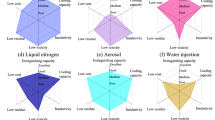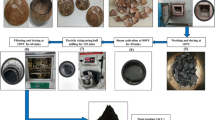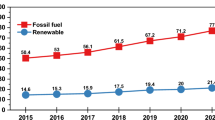Abstract
The accelerating rate calorimetry is a powerful tool for thermal hazard evaluation. However, the existing kinetics approaches ignore the fact that the thermal inertia is varying during the pseudo-adiabatic reaction because of the changing of the sample’s heat capacity and heat loss. To overcome this shortcoming, the expression of the thermal inertia is amended based on the heat balance and transfer in this article. The arithmetic product of the sample’s heat capacity and the amended thermal inertia is obtained by merging the kinetic results of the DSC and ARC data. Then, the data from the ARC are corrected and the more reasonable values of the kinetic parameters are computed based on the varying thermal inertia consideration. With the typical n-order and autocatalytic decomposition experiments under the different sample masses, the validity of the proposed kinetic approach is verified. Meanwhile, the hypotheses of the proposed approach are analyzed and discussed in the end of the article.











Similar content being viewed by others

Abbreviations
- Φ :
-
Constant thermal inertia
- C s :
-
Heat capacity of the sample (J g−1 K−1)
- M s :
-
Mass of the sample (g)
- C b :
-
Heat capacity of the sample container (J g−1 K−1)
- M b :
-
Mass of the sample container (g)
- Φ(T, t):
-
Varying thermal inertia
- P ex :
-
Heat generation rate of the sample (mW)
- P loss :
-
Heat loss rate of the sample (mW)
- α :
-
Extent of conversion
- A, A1, A2 :
-
Pre-exponential factor (s−1)
- E, E1, E2 :
-
Activation energy (J mol−1)
- T(t):
-
Temperature (K)
- R :
-
Gas constant (8.314 J mol−1 K−1)
- n, n1, n21, n22:
-
Reaction order
- t :
-
Time (s)
- H :
-
Heat release (J)
- T f :
-
Final temperature of reaction in ARC (K)
- T o :
-
Onset temperature in ARC (K)
- N :
-
Sampling number
- β :
-
Heating rate in DSC experiment (K min−1)
- i :
-
Index of the different heating rate in DSC experiments
- A α :
-
Pre-exponential factor (s−1)
- E α :
-
Activation energy (kJ mol−1)
- f(α):
-
Kinetic model
- T α,i :
-
Temperature (K)
- Δαmin :
-
Minimum internal of α
- CS(T,t)Φ(T,t):
-
Arithmetic product of sample heat capacity and amended thermal inertia
- RSS:
-
Residual sum of squares
References
Stoessel F. Thermal safety of chemical processes. Weinheim: Wiley-VCH Verlag GmbH & Co. KGaA; 2008.
Zhao GB. Beyond the phi factor: correction of experimental data for vaporization in tempered reactions for pressure-relief system design. Process Saf Prog. 2015;34(2):130–6.
Townsend DI, Tou JC. Thermal hazard evaluation by an accelerating rate calorimeter. Thermochim Acta. 1980;37:1–30.
Chippett S. Low thermal inertia scanning adiabatic calorimeter. US Patent US7021820; 2006.
Wu FL. Differential adiabatic compensation calorimeter and methods of operation. US Patent 2015/0124851A1; 2015.
Xu QY, Ding J, Yang SJ, Ye SL. Modeling of a power compensated adiabatic reaction system for temperature control design and simulation analyses. Thermochim Acta. 2017;657:104–9.
Fisher HG, Goetz DD. Determination of self-accelerating decomposition temperatures for self-reactive substances. J Loss Prev Process Ind. 1993;6(3):183–94.
HarsNet. Thematic network on hazard assessment of highly reactive systems, Part 6, HarsBook. In: A technical guide for the assessment of thermal hazards in highly reactive chemical systems. DECHEMA (part 6 adiabatic calorimetry); 2003.
Fisher HG, Forrest HS, Grossel SS. Emergency relief system design using DIERS technology: the design institute for emergency relief systems (DIERS) project manual. Emergency relief system design using DIERS technology; 2010.
Wilcock E, Rogers RL. A review of the phi factor during runaway conditions. J Loss Prev Process Ind. 1997;10(5–6):289–302.
Kossoy AA, Singh J, Koludarova EY. Mathematical methods for application of experimental adiabatic data—an update and extension. J Loss Prev Process Ind. 2015;33:88–100.
Kossoy AA, Koludarova E. Specific features of kinetics evaluation in calorimetric studies of runaway reactions. J Loss Prev Process Ind. 1995;8(4):229–35.
Roduit B, Hartmann M, Folly P, Sarbach A, Brodard P, Baltensperger R. Thermal decomposition of AIBN, part B: simulation of SADT value based on DSC results and large scale tests according to conventional and new kinetic merging approach. Thermochim Acta. 2015;621:6–24.
Roduit B, Hartmann M, Folly PA, Sarbach A, Brodard P, Baltensperger R. New kinetic approach for evaluation of hazard indicators based on merging DSC and ARC or large scale tests. Chem Eng Trans. 2016;48:37–42.
Saha N, Al-Muhannadi R, Al-Muhannadi A, Vechot LN, Castier M. Is it the time to say bye to the Φ-factor? Process Saf Environ Prot. 2018;113:193–203.
Ding J, Yu LM, Wang JC, Xu QY, Yang SJ, Ye SL. A symmetric dual-channel accelerating rate calorimeter with the varying thermal inertia consideration. Thermochim Acta. 2019;678:178304.
Kossoy AA, Sheinman I. Effect of temperature gradient in samples cells of adiabatic calorimeters on data interpretation. Thermochim Acta. 2010;500:93–9.
Vyazovkin S, Burnham AK, Criado JM, Pérez-Maqueda LA, Popescu C, Sbirrazzuoli N. ICTAC Kinetics Committee recommendations for performing kinetic computations on thermal analysis data. Thermochim Acta. 2011;520:1–19.
Roduit B, Folly P, Berger B, Mathieu J, Sarbach A, Andres H, Ramin M, Vogelsanger B. Evaluating SADT by advanced kinetics-based simulation approach. J Therm Anal Calorim. 2008;93:153–61.
Vyazovkin S, Chrissafis K, Lorenzo MLD, Koga N, Pijolat M, Roduit B, Sbirrazzuoli N, Sunol JJ. ICTAC Kinetics Committee recommendations for collecting experimental thermal analysis data for kinetic computations. Thermochim Acta. 2014;590:1–23.
Wang SY, Kossoy AA, Yao YD, Chen LP, Chen WH. Kinetics based simulation approach to evaluate thermal hazards of benzaldehyde oxime by DSC tests. Thermochim Acta. 2017;655:319–25.
AKTS. AKTS-thermokinetics and AKTS-thermal safety software. http://www.akts.com.
Kersten RJA, Boers MN, Stork MM, Visser C. Results of a Round-Robin with di-tertiary-butyl peroxide in various adiabatic equipment for assessment of runaway reaction hazards. J Loss Prev Process Ind. 2005;18:145–51.
Duh YS, Kao CS, Lee WLW. Chemical kinetics on thermal decompositions of di-tert-butyl peroxide studied by calorimetry. J Therm Anal Calorim. 2017;127:1071–87.
Duh YS, Kao CS, Lee C, Yu SW. Runaway hazard assessment of cumene hydroperoxide from the cumene oxidation process. Process Saf Environ Prot. 1997;75:73–80.
Duh YS. Chemical kinetics on thermal decompositions of cumene hydroperoxide in cumene studied by calormetry: an overview. Thermochim Acta. 2016;637:102–9.
Roduit B, Hartmann M, Folly P, Sarbach A, Baltensperger B. Prediction of thermal stability of materials by modified kinetic and model selection approaches based on limited amount of experimental points. Thermochim Acta. 2014;579:31–9.
Xu QY, Ding J, Yang SJ, Ye SL. Measurement and calculation method of changing heat capacities during the reaction. Thermochim Acta. 2019;675:55–62.
Höhne GWH, Hemminger WF, Flammersheim HJ. Differential scanning calorimetry. 2nd ed. Berlin: Springer; 2003.
Acknowledgements
This work was supported by Zhejiang Provincial Public Welfare Research Program (Grant No. LGF18B030001) and Zhejiang Provincial Natural Science Foundation of China (Grant Nos. LY17F010011, LQ15F030003).
Author information
Authors and Affiliations
Corresponding author
Additional information
Publisher's Note
Springer Nature remains neutral with regard to jurisdictional claims in published maps and institutional affiliations.
Rights and permissions
About this article
Cite this article
Ding, J., Yu, L., Wang, X. et al. A kinetic-based approach in accelerating rate calorimetry with the varying thermal inertia consideration. J Therm Anal Calorim 141, 783–796 (2020). https://doi.org/10.1007/s10973-019-09081-z
Received:
Accepted:
Published:
Issue Date:
DOI: https://doi.org/10.1007/s10973-019-09081-z



